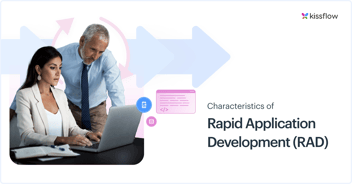
- >
- Application Development >
- RAD and JAD: The Key Differences And Benefits
RAD and JAD: The Key Differences And Benefits
Team Kissflow
Updated on 5 Apr 2024 • 4 min read
Scaling enterprise application development poses a critical but formidable challenge for CIOs. The right approach to application development can improve enterprise scalability and agility while decreasing time to market.
The two different development approaches that can be considered by organizations are RAD (Rapid Application Development) and JAD (Joint Application Development).
But how do they differ from each other, and which methodology do you use for your business? Let's find out.
RAD vs JAD
Rapid application development (RAD) is an application development process that allows developers to make multiple iterations and updates to software quickly. It’s an agile and progressive development model that emphasizes rapid prototyping and quicker feedback. This ensures that the end product is more quality-focused and aligns with the end-users requirements. RAD helps organizations develop new products and features quickly and stay competitive in a fast-evolving digital world.
Joint application development (JAD) is another common technique used in application development. It brings together key project stakeholders, technology experts, and business representatives through a series of workshops. Its ultimate purpose is to include the client in the development process to develop a better end-product that will meet their needs more efficiently. The client has full autonomy and participates in application development through a series of workshops.
The main differences between RAD and JAD
|
Rapid Application Development |
Joint Application Development |
|
Fewer people are involved in software development. |
Stakeholders work together on software development. |
|
More emphasis is placed on application development and prototyping. |
More emphasis is placed on planning tasks for application development. |
|
The focus is on rapid development and quick deployment of quality technology. |
Feedback is vital during the development phase and gives stakeholders a sense of ownership. |
|
Offers fast-paced app development with the advantage of reduced costs. |
Because of the way systems are designed, the process is expensive. |
|
Requirements can be changed at any time because the method’s key objective is rapid development. |
The end product can’t be changed easily because approval is required from different stakeholders. |
|
Suitable for unstructured projects. RAD developers can make numerous iterations and updates to the product under development without restarting the development schedule. |
Suitable for dynamic system development. It is an effective tool in searching for and correcting issues during system analysis and enhancing design quality. |

How to Choose an App Development Platform for Your Enterprise [ Checklist Included ]
Thank you for reaching us!
Thank you for reaching us!
Benefits of implementing a RAD model
According to Gartner’s survey on mobile apps, the major hurdles to app development are time, cost, and technical skill gaps. RAD lessens the impact of those factors on app development.
The development model focuses on quick prototyping and iterative development and is very different from the JAD model which focuses on planning and sequential design. Here are six of its benefits:
-
Reduced app development cycle time
-
Faster code generation
-
It’s easy to modify apps
-
Rapid user feedback
-
Timely systems integration
-
Aligned IT and business teams
1. Reduced app development cycle time

Because the entire project is divided into modules which are treated as individual prototypes, prototypes can be tested instantly before being combined. This makes for faster app delivery. Businesses find it easier to maintain budgets and schedules and to measure progress. They improve their time to market and achieve their business goals.
“RAD allows progress to be accurately and quickly measured. It also provides a reduction in development time and the ability to garner constant customer feedback,” says Scott Stiner, Forbes Councils Member.
2. Faster code generation
Rapid application development platforms have code generators and allow for code reuse, so there’s less manual coding. Prototypes can be transferred as scripts, so producing working prototypes becomes easier. Processes that would take months or even weeks take days. The model allows developers to work faster while decreasing infrastructure and server needs for cloud development environments.
3. It’s easy to modify apps
Rapid application development makes it compulsory for developers to build independent elements that comprise the final application. Every component is compartmentalized and can be modified to improve the software. This ensures better quality, lower application development costs, and faster development lifecycles.
4. Rapid user feedback
App development usually involves many stakeholders. There are internal teams and stakeholders who approve the project and continually track its progress. These people aren’t IT-savvy and often work in different departments with unique needs. But the feedback they give is essential for successful development.
Because the RAD model allows for continuous feedback, software developers can get feedback from the end users and easily incorporate it to enhance the final product. Development teams get the feedback they require to fast-track the project, while users get the access they need to monitor progress.
5. Timely systems integration
Rapidly developed applications are integrated with other business systems almost immediately. By enabling early integrations, the RAD development model quickly highlights errors within integrations and triggers immediate resolution. Stakeholders can quickly identify and discuss errors, complications, or code vulnerabilities and resolve them without impacting development progress. This reduces risk, which in turn reduces costs.
6. Aligned IT and business teams

80% of IT professionals across the globe admit they spend at least half their time on rework. This happens because of differing views between IT and business users. RAD streamlines the development process by aligning IT and business teams in all processes: requirements planning, design, testing, and implementation. The technology has a shorter planning phase and focuses on highly iterative design and construction, so development teams are able to accomplish more in less time without sacrificing product quality.
RAD is the app development model of choice
RAD’s adaptability allows developers to make multiple iterations and updates to software quickly. There’s no need to restart a development schedule from scratch every time. The model reduces the overall development time due to reusable components and parallel development, enabling rapid delivery.
Development teams can leverage simple code-change capabilities and dramatically enhance the functionalities of finished software without wasting time or overlooking critical errors. Rapid application development also encourages code reuse. Less manual coding means shorter testing times and less room for errors.
Kissflow's low-code platform can simplify and accelerate application development by involving even non-technical users in the development process. With Kissflow’s visual drag-and-drop editor, your apps get developed faster, and the solutions align much more closely with your business requirements. While allowing your business users to leverage their domain experience, Kissflow also lets your IT team take over anytime and manage governance.
The fastest way to create high-value apps
-3.webp)








